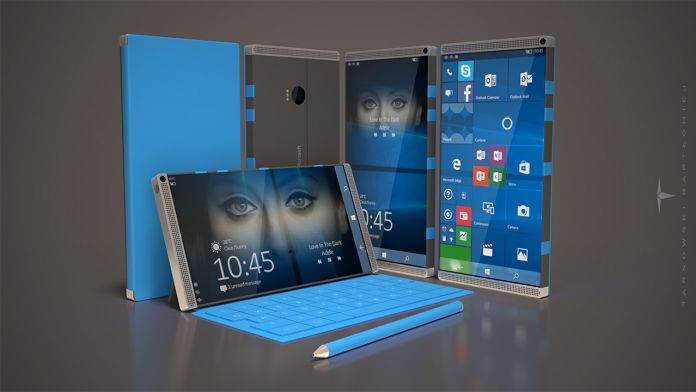A couple of new patents show the company is still deep in development of such a device. By now it is clear Microsoft is working on a device with two folding screens. Whether that hardware will ever be released remains to be seen, but the company is pushing to revolutionize mobile. The two new patents enhance the folding screen technology. The first addresses an issue with how to interact with a device split across two screens, while the second solves how light displays accurately on a curved display. US 2018/0113520 A1 comes with images of a folding display. We have seen this type of design in other Microsoft patents. While obviously not showing a finalized hardware aesthetic, the patents do consistently show what kind of device the company is building. Namely, a mobile device that will open like a book and display two screens.
This first patent wants to address how OS interaction will work with folded panels. Microsoft describes the challenges in the patent notes. “Consequently, a typical gesture language may be inefficient for these devices given the ergonomics of holding and interacting with such a device. This can detract from user enjoyment and lead to user frustration when using these types of devices.” To solve this problem, the company describes “hinge gestures” where the operating system is fully compatible with hinged hardware. “In some implementations, interactions with the hinge can be combined with one or more additional input signals to modify an operation associated with the hinge interaction. These additional input signals can include a variety of different input signals, such as an indication of an orientation of the device, a velocity at which the hinge interaction is performed, touch signals indicating how the user is holding the device, and so on. Accordingly, a variety of different input signals can be combined with the hinge interaction to modify the operation associated with the hinge interaction.” “Use of an approximate hinge angle to switch between two or more discrete views of content or UI on one or more connected display screens, such as switching between different views of a dataset or showing/hiding chrome elements.”
The second patent is listed as US 2018/0113241 A1 and like the first was published by Microsoft on April 26. Because the folding device will employ curved screen technology, it could be difficult to distribute light on the dual screens. Unlike current smartphone screens, information because harder to accurately render when on a curved panel. Microsoft gets technical in solving the issue, but explains its solution in the patent: “An electronic display comprises a display matrix, an image-correcting layer, and a luminance-correcting layer. The display matrix includes a flat face portion, a curved corner portion, a light-releasing surface, and a series of pixels extending across the flat face portion and around the curved corner portion. Coupled to the light-releasing surface of the display matrix, the image-correcting layer is configured to transmit light released from the flat face portion of the display matrix and to reorient light released from the curved corner portion of the display matrix such that the transmitted light and the reoriented light exit the image-correcting layer substantially in parallel, forming an apparent plane image of the series of pixels. Arranged between the light-releasing display surface and the image-correcting layer, the luminance-correcting layer is configured to deflect the light released from the curved corner portion into an acceptance profile of the image-correcting layer.”
Surface Phone
So, Microsoft’s view for the future of mobile technology is taking shape. We know the company is working on solutions such as Windows CShell and Windows 10 on ARM. The former will let the platform distribute across form factors and create a truly equal unified experience. Windows 10 on ARM could lead to full PC applications running on mobile devices. With that in mind, the company is clearly pursuing a cross between full PC capabilities on a handheld device. Of course, the real question is whether consumers want or even need such hardware. Perhaps Microsoft believes it can carve a mobile niche in the ever-important enterprise market? Either way, whether the eventual folding screen device becomes the much-rumored Surface Phone is a question for another day.






